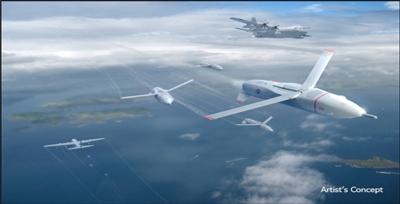Mon, Mar 27, 2017
Testing Ability To Recover Unmanned Aerial Vehicles On The Fly
DARPA recently completed Phase 1 of its Gremlins program, which envisions volleys of low-cost, reusable unmanned aerial systems (UASs)—or “gremlins”—that could be launched and later retrieved in mid-air. Taking the program to its next stage, the Agency has now awarded Phase 2 contracts to two teams, one led by Dynetics, Inc. (Huntsville, Ala.) and the other by General Atomics Aeronautical Systems, Inc. (San Diego, CA).

“The Phase 1 program showed the feasibility of airborne UAS launch and recovery systems that would require minimal modification to the host aircraft,” said Scott Wierzbanowski, DARPA program manager. “We’re aiming in Phase 2 to mature two system concepts to enable ‘aircraft carriers in the sky’ using air-recoverable UASs that could carry various payloads—advances that would greatly extend the range, flexibility, and affordability of UAS operations for the U.S. military.”
Gremlins Phase 2 research seeks to complete preliminary designs for full-scale technology demonstration systems, as well as develop and perform risk-reduction tests of individual system components. Phase 3 goals include developing one full-scale technology demonstration system and conducting flight demonstrations involving airborne launch and recovery of multiple gremlins. Flight tests are currently scheduled for the 2019 timeframe.
Named for the imaginary, mischievous imps that became the good luck charms of many British pilots during World War II, the program envisions launching groups of UASs from multiple types of military aircraft—including bombers, transport, fighters, and small, unmanned fixed-wing platforms—while out of range of adversary defenses. When the gremlins complete their mission, a C-130 transport aircraft would retrieve them in the air and carry them home, where ground crews would prepare them for their next use within 24 hours.
The gremlins’ expected lifetime of about 20 uses could provide significant cost advantages over expendable unmanned systems by reducing payload and airframe costs and by having lower mission and maintenance costs than conventional manned platforms.
(Image provided with DARPA news release)
More News
Also: Vertical Flight Society, NBAA Maintenance Conference, GA Honored, AMT Scholarship For the first time, students from Embry-Riddle’s Daytona Beach, Florida, campus took t>[...]
Hazardous Weather Information Summary of significant meteorological information (SIGMET/WS), convective significant meteorological information (convective SIGMET/WST), urgent pilot>[...]
"The need for innovation at speed and scale is greater than ever. The X-62A VISTA is a crucial platform in our efforts to develop, test and integrate AI, as well as to establish AI>[...]
(FAA) Inspector Observed That Both Fuel Tanks Were Intact And That Only A Minimal Amount Of Fuel Remained In Each Analysis: According to the pilot, approximately 8 miles from the d>[...]
“Pyka’s Pelican Cargo is unlike any other UAS solution on the market for contested logistics. We assessed a number of leading capabilities and concluded that the Pelica>[...]
 Airborne-Flight Training 05.09.24: ERAU at AIAA, LIFT Diamond Buy, Epic A&P
Airborne-Flight Training 05.09.24: ERAU at AIAA, LIFT Diamond Buy, Epic A&P ANN's Daily Aero-Term (05.07.24): Hazardous Weather Information
ANN's Daily Aero-Term (05.07.24): Hazardous Weather Information Aero-News: Quote of the Day (05.07.24)
Aero-News: Quote of the Day (05.07.24) NTSB Final Report: Cessna 150
NTSB Final Report: Cessna 150 Aero-News: Quote of the Day (05.08.24)
Aero-News: Quote of the Day (05.08.24)



